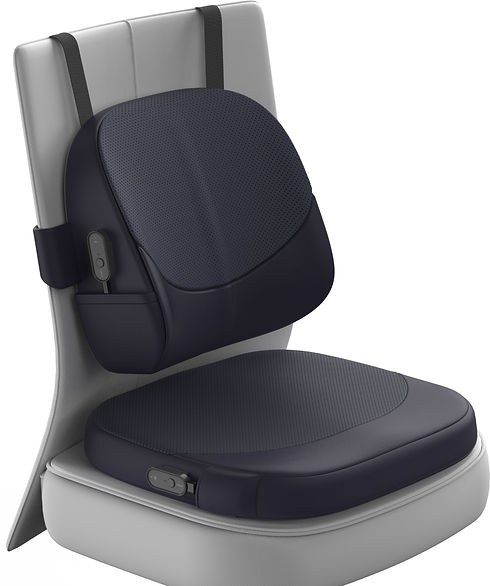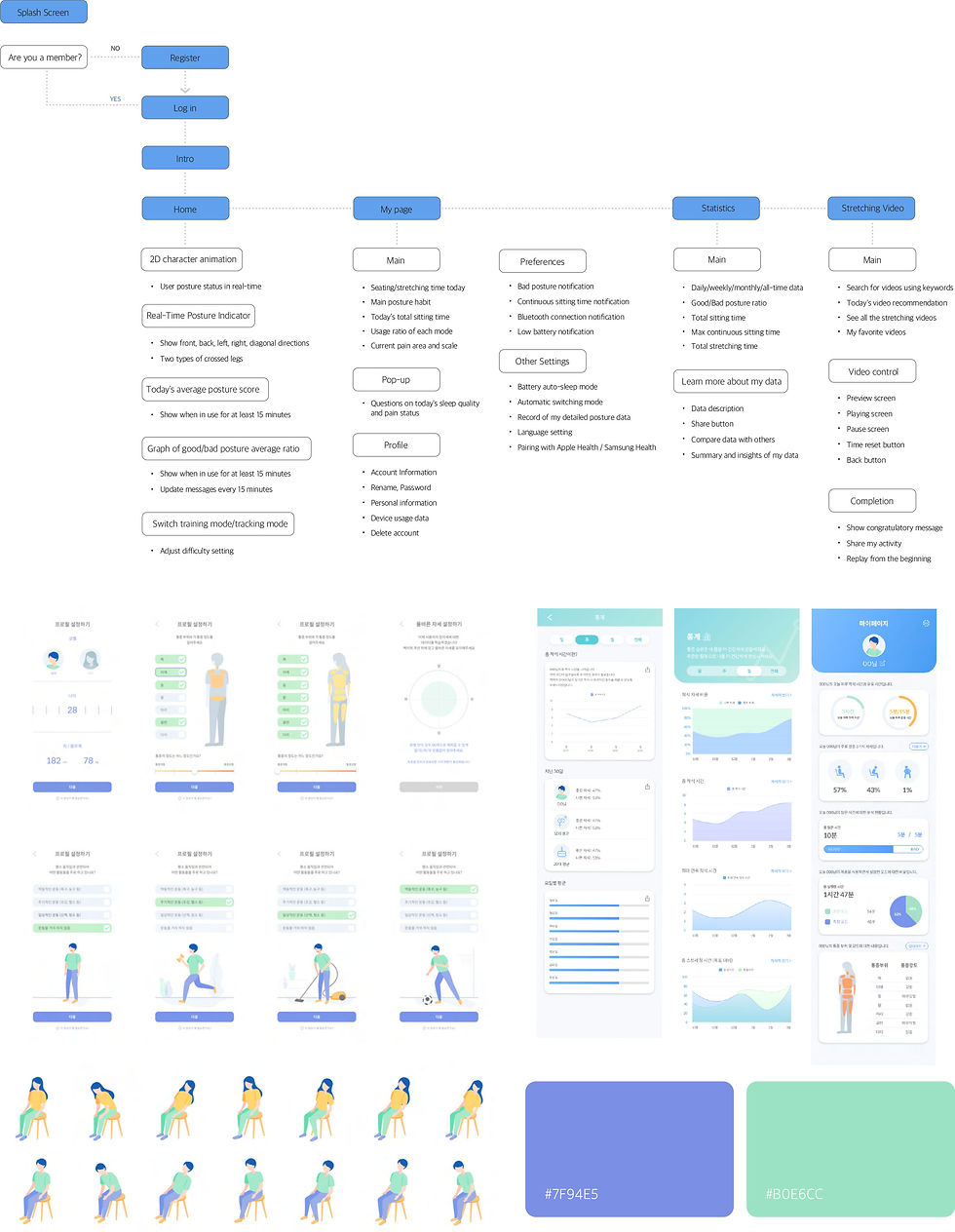
Keeper
Date: May 2019 - Dec 2021
Role: Project Lead, Product Design
Range: Ideation to Production
Collaborators:
Seoho Ahn (Product Designer),
Sungwoo Oh (Mechanical Engineer),
Seokhee Lee (Front-end Engineer),
Yechan Lee (Back-end Engineer),
Dahee Han (Visual Designer),
HCLAB Inc,
Ergonomics Design Lab at Korea University,
The Ace Inc
Outcomes:
Represented Korean Team in the Dyson Award (2023)
Winner in Global Design Award by K-Design (2022)
2nd in KAIST Silicon Valley Workshop Program (2022)
Launched on App Store and Google Play (2021)
TOP 10 in Global Digital Talent by Alibaba (2021)
Technology patent registration (2021)
Award in Busan ICT & Smart Healthcare Contest (2020)
Seoul Mayor's Prize in X-Tech Competition (2020)
Achieved 1,012% crowdfunding in Wadiz (2020)
Technology patent registration (2019)

BACKGROUND
Having experienced scoliosis in childhood due to poor posture, I underwent several treatments and rehabilitation, which significantly improved my condition. However, as an adult, I still had a slight spinal curvature. This personal experience deeply influenced my academic focus as a researcher in Korea University's Ergonomics Lab. Drawing from my personal and academic experiences, I was driven to undertake a project that addressed posture-related issues. I focused on designing chair cushions with integrated IoT features for self-managed posture correction. These smart cushions allow users to independently adjust their posture, potentially reducing the need for frequent medical consultations or rehabilitation. This project not only reflects my journey but also aims to empower others to proactively manage their spinal health through innovative, everyday solutions.

DESIGN PROCESS - THE FOAM
The project adopts an ergonomic approach with specialized memory foam, blending high-density and low-resilience materials for durable support and comfort. the foam features a unique cell structure with key layers, each designed for a specific function.
Outer Foam: Curved to guide correct pelvic and lower back posture, essential for maintaining alignment while seated.
Ventilated Foam: Located at high-contact areas, it maximizes breathability, reducing heat and moisture for enhanced comfort.
Central Foam: Features a central hole and protrusion, distributing pressure evenly to minimize stress on the buttocks and lower back.
Acupressure Foam: Soft protrusions provide gentle acupressure for thigh and lower back muscles, aiding in muscle relaxation and blood circulation.
The considerable time invested in designing the foam was to ensure that the cushion, as an object itself, fully realized its intended function. Many IoT products often focus too much on tech features that they compromise the design quality of the object itself. With this in mind, my goal was to create a product design that would stand on its own merit, even without its IoT functionalities.

DESIGN PROCESS - HARDWARE (IoT)
Next, we selected Force Sensitive Resistor (FSR) sensors for precise posture measurement in both cushion and backrest designs. After many tests, we determined that 32 sensors optimally detect 11 basic postures. Additionally, we integrated features to standardize posture data, accommodating daily variations like clothing thickness and incorporating a reset function for different users. This emphasized the necessity of an accompanying app. Initially prototyped with Arduino boards, we collaborated with experts to refine the design, incorporating specialized circuits and mechanical expertise.
The main IoT components included:
FSR Sensor Board: A 32-point pressure-detecting sensor with a 34-pin connector, where pins 1 and 34 supply 5 volts. A microcontroller reads these voltages to determine pressure points.
Microcontroller: Manages inputs/outputs, controls display, communicates with the app via Bluetooth, and manages power modes.
Analog-Multiplexer: Transmits FSR sensor signals to the microcontroller sequentially.
Regulator-LDO: Supplies stable voltage to the microcontroller, optimized for low power consumption in standby.
Bluetooth Module: Facilitates data communication between the app and microcontroller via BLE chip.
Vibration Motor: Activates based on app setting for posture alerts, with motor controlled by Algorithm.
LED Display: Shows battery charging and status, and Bluetooth connectivity.

DESIGN PROCESS - SOFTWARE (APP)
We felt the need to develop an app to set standard posture data for each user and customize feedback. As the product concept involved providing slight vibration alerts for poor posture, the app needed to allow users to set vibration intensity and feedback timing. Deciding to fully develop the app, we faced a challenge: storing real-time data from 32 sensors made the app too heavy. We resolved this by storing sensor data on a separate server, accessed as needed via a backend system.
App features included:
Profile Registration: Collects user data like gender, age, height/weight, spinal pain areas/intensity, and activity levels for customized content.
Character Animation: Shows real-time 2D animations of the user's posture, indicating deviations from correct alignment.
Difficulty Settings: Allows users to set thresholds for receiving haptic feedback based on posture deviations.
Statistics: Offers daily, weekly, and monthly posture data with detailed explanations, allowing users to compare their posture scores with others.
Stretching Video: Recommends stretching videos based on occupation, working hours, posture status, and usual pain areas/intensity.
Settings: Adjust vibration patterns and intensity, with options to toggle various notifications like low battery, and Bluetooth connection status.

PROCESS - DATA (ALGORITHM)
The goal of this algorithm development is to predict user posture in real-time using a cushion equipped with 32 FSR sensors. Additionally, the algorithm aims to cluster similar posture patterns and predict potential health issues using user data surveyed through the app. The project involves combining sensor raw data with user data (including gender, age, height, weight, activity levels, pain areas, and spinal disorders history, etc.) to create a comprehensive dataset for AI training. The experimental process is as follows.
Data Collection: Involved 70 participants over a 2-hour session, adopting various postures, along with user data collection for personalized analysis.
Data Processing: The sensor and user data were systematically formatted for AI training, aligning posture labels with corresponding sensor readings and user characteristics.
Model Development: Developed a machine learning model, likely a Convolutional Neural Network, to interpret sensor data and user data for posture prediction and health pattern identification.
Training and Validation: Trained on the tested dataset, focusing on accuracy in posture prediction and the ability to correlate postures with user-specific health data.
Testing: Evaluated the model's accuracy and its effectiveness in utilizing user data.
Deployment: Integrated the model with the cushion product for real-time analysis, supported by a computational setup.
Outcome: The project achieved a significant milestone in posture prediction accuracy and health analysis precision. The most effective model configuration identified was a Batch Size of 16 and 30 Epochs. This model was chosen as the setup achieved a training accuracy of 93% and a validation accuracy of 93%.

REFLECTION
My journey from ideation to mass production in this project was a deep dive into the complexities of IoT product development. The process was both challenging and expensive, necessitating collaborations with designers, developers, manufacturers, and many agencies. The interconnected nature of these tasks emphasized the importance of strong communication skills, as any single error could have far-reaching consequences. A pivotal learning from this project was the significance of financial management. Transitioning from a background in design, and academic research to leading a startup was a major shift. Despite receiving government grants and investments, I learned the hard way about necessity of financial due diligence. The financial oversight led to an unexpected situation where my team and I found ourselves manually assembling products due to a shortage of funds. Another critical issue was over-engineering. Our initial concept was simple: a product to assist users in recognizing and correcting their posture. However, the project's scope expanded significantly as we integrated an app, animations, backend solutions, statistics, and content recommendations. This expansion resulted in a product that was too complex and prone to errors, leading to over 10% of our crowdfunding backers returning it due to these issues. Although it's difficult to label the project as a market success, the experience was immensely rewarding. It contributed significantly to my personal and professional growth and paved the way for my next venture with Charco. I'm deeply grateful to everyone involved, particularly my team, who dedicated themselves to crafting a great product from the beginning.
Originally 'BackKeeper' in the video, renamed to 'HipKeeper' post-backrest cushion release.